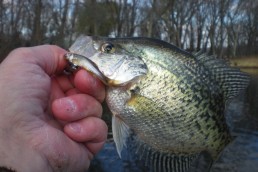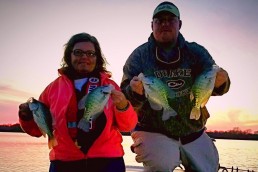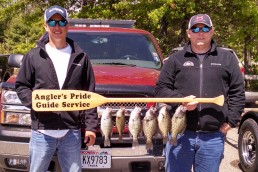April Means Crappies
SHARE THIS POST
My new Mercury 200 Pro XS fired right up. The Humminbird Helix 12 started recording bottom and quickly locked up on GPS satellites. The sun was warm, the wind was light, and there was a hint of humidity in the air. As I picked my father up at the dock from parking the truck, my son flashed an excited grin at me.
We ran to a shallow, protected bay on the far side of the lake, and my dad got out ultralight panfish rods for the three of us as I dropped the MinnKota Ulterra into the water, started up the remote for it, and started up the bow Humminbird. We got my little guy’s line in the water first—a 1/16-ounce VMC Moon Eye Jig tipped with a Berkley PowerBait 2” Minnow suspended under a Thill slip float four feet below the surface—a foot above the two-foot-tall weeds in the bay. Before my Dad and I could get our lines wet, Parker’s float went under. He knew what to do, and a 9-inch crappie was soon in the boat.
“Nice going, Parker,” from my dad was followed by Parker asking, “Can we keep it, dad?” “Sure, we can keep a few to eat fresh,” I answered. With all three of our lines in the water, this scene repeated itself time and again until we had caught our fill of nice crappies, and even kept a few for dinner. Besides, Parker was ready for dinner.
Anglers dream about this for months: The ice is coming off area lakes, and the tarps are coming off fishermen’s boats. It is springtime in the Midwest. Since the fishing seasons for gamefish like walleyes and bass don’t open for several weeks yet in many Midwestern states, fishermen determined to launch their boat and wet a line are thinking of crappies.
Crappies will soon be moving shallow for one reason—to feed! In the right conditions, they can be tough to keep off your line. As soon as the ice leaves shallow bays and backwaters, all it takes is a few consecutive warm, sunny days to get crappies into the shallows to chase minnows and insects that become active in the warmer water of dark-bottom, protected bays. If you can find the right spots, fish at the right times, and use the right presentations, crappies can provide some fast action.
Look for shallow, dark-bottom bays with access to deep water. Crappies that were suspending over deep water during the winter will move into these bays as warm, sunny days begin to warm the shallow water the fastest of any areas of the lake. Some type of cover like weeds or brush present in a bay of this type is a definite plus. Submerged weeds will be sparse after the long winter, so look for some of the thickest clumps and you will probably find a group of crappies.
If you can find a bay of this type on the north side of a lake, so much the better. Northern bays will warm even quicker due to the spring sun’s position in the southern sky. If conditions are sunny and calm, you can often spot crappies flashing after minnows with the aid of polarized sunglasses.
These bays are not full of active crappies at all times in the spring. A stretch of cold weather will drive them out deeper again, as such a stretch can quickly cool the water in a shallow bay during spring. Try to fish during warmer, sunnier stretches of weather if possible. Mid-day to late-day on days such as this are best as the water in shallow, dark-bottom bays can actually warm several degrees by later in the day as compared to early morning.
Drops in air pressure associated with storm fronts can really shut down a shallow-water crappie bite in the springtime. Try to fish stable conditions.
Finally, calm days are usually better than windy ones, especially if the area you are fishing is exposed to the wind. Gusty winds and large waves can make spotting fish and submerged cover more difficult, and they can make fishing with light tackle difficult.
Are you enjoying this post?
You can be among the first to get the latest info on where to go, what to use and how to use it!
I like to search an area for feeding crappies using a “horizontal” approach. I combine a 1/16-ounce roundhead jig with a small jig spinner, and tip it with a small soft plastic. Scented plastics like Powerbait or Gulp by Berkley come in many small forms such as minnows, grubs and tubes that work well on this panfish-sized “spinnerbait.” I use the trolling motor and polarized sunglasses to search for cover, casting this presentation and “slow-rolling” it along. Active crappies will almost always hit this combo. Sometimes they may “short-bite” it, but they will reveal their presence.
For this presentation, I like to use a 6’6” or 7’ ultralight, moderate-action spinning rod with a good ultralight spinning reel spooled with 4-pound-test Berkley Nanofil Clear Mist. Nanofil is a unifilament “super line” that casts and retrieves nicely with spinning gear. It has a very small diameter and has no “memory,” which makes it perfect for use with small, light tackle.
I tie the Nanofil to a tiny barrel swivel, and then run a leader of 4-pound-test fluorocarbon from the swivel to the bait. The longer, softer action rod “gives” just enough to allow the crappies to inhale the bait to ensure a hook-up. The fluorocarbon leader is for near-invisibility to prevent spooking fish. If crappies are slamming this, I continue to fish with this rig.
If crappies short-bite the jig-spinner, or if I am confident crappies are in a specific spot, I go to a “vertical” presentation like we were using that April day described in the opening. This consists of a slip float above a 1/16-ounce jig. I tip the jig with scented plastic tubes, minnows, grubs or nymphs. If fish are finicky and don’t hold onto the scented plastic long enough to get a hookset, I will switch to a small crappie minnow or a waxworm. This isn’t necessary very often.
I like to use a 7’ or 7’6” ultralight spinning rod with a good ultralight spinning reel spooled with 4-pound-test Nanofil. Again, I tie this to a tiny barrel swivel, with a leader of 4-pound-test fluorocarbon from the swivel to the jig for stealth. The longer rod, combined with the no-stretch line, makes it much easier to take up slack line on the hookset and get the jig set home. You need to keep a tight line, because you often need to be quick with the hookset when a fish takes the bobber down. When using soft plastics, if you miss a bite, leave the rig sit and a fish will often hit it again and again until you can hook it. This is tough to do with live bait which often tears off on a missed bite.
For either of these techniques, I use my MinnKota to move around slowly, looking for fish. When I find fish, I use the Spot-Lock feature of my Ulterra I-Linked to my Humminbird to hold on a spot. If the spot dries up, I am back on the move until I locate more fish—no pulling up a mud-and-weed-covered anchor, spooking fish and wasting time. This feature actually holds a boat better in windy conditions over soft bottom than many small anchors used by fishermen. I have had boats nearly drift into me with a dragging anchor fishing crappies in early spring.
April is here, and the lakes are opening up. Get the boat out of storage, head to an area lake with a good crappie population, and go catch some early spring crappies. It can be some fast action, and provides a great opportunity to enjoy the change of seasons in Minnesota. This is also a great chance to get kids out in the boat on a nice day with fast fishing action—all the ingredients needed to “hook” kids or keep them “hooked” on fishing. Depending on the weather, this pattern can start as early as the beginning of April, and can last as late as mid-May in Midwestern lakes.
Please practice selective harvest at this time of year. Female crappies will be full of eggs, preparing for the spawn in several weeks. Overharvest of fish can damage the next generation, so please avoid “freezer filling.” Also, put back the larger crappies, and keep those eight- to ten-inchers to eat. Large crappies take time to grow in Midwestern lakes, and they are very vulnerable to overharvest in the spring.
Get out on the water and enjoy the fishing that spring has to offer—you won’t be disappointed.
MWO
SHARE THIS POST
Did you enjoy this post?
You can be among the first to get the latest info on where to go, what to use and how to use it!
Troy Smutka
Troy Smutka is a central Minnesota fishing guide (greatdayonthewater.com) and a walleye tournament angler. He is also a member of the Lund Boats, Mercury Outboards and Johnson Outdoors Pro Teams, and hosts and produces Fishing and Hunting the North Country on YouTube.



